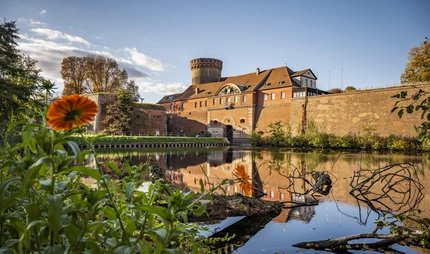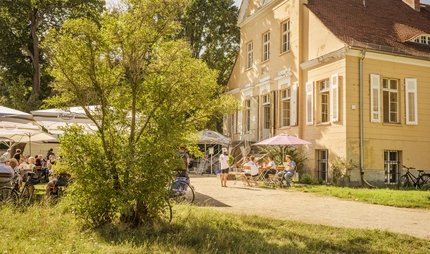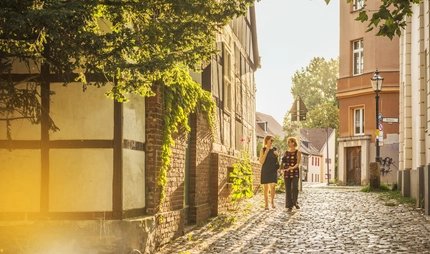
Historic Spandau
A history spanning centuries
In Spandau there are so many listed buildings and historical objects to discover – in fact, every corner has its own story to tell.
Zitadelle Spandau
First of all, treat yourself to an impressive view by climbing the 13th century Juliusturm. The old fortified tower, which is incidentally the oldest building in Berlin, stands in the middle of the Zitadelle, a square fortress built in the 16th century. It is completely surrounded by water and is one of the most important and best-preserved Renaissance fortresses in Europe. Within its thick walls there are now museums where you can see fascinating objects that tell the story of the past – from pieces of armour, helmets and weapons to pewter figure dioramas. Your children will love the darkened bat room where you can see the citadel’s nocturnal inhabitants right up close. Since 2016, the former provisions depot has housed the permanent exhibition “Unveiled. Berlin and its Monuments”, where you can see political monuments from all over Berlin which were once part of the urban landscape. Famous examples include a whole set of statues of the rulers of Brandenburg and Prussia which used to be installed at the Tiergarten, as well as the “Decathlete” by Arnold Breker. One of the exhibits gained international fame from the film “Goodbye Lenin”: the head of the monumental Lenin statue unveiled in 1970 in Friedrichshain.
Spandauer Altstadt
Right opposite the citadel is the Spandauer Altstadt, the old town centre with remnants of the historic wall, old half-timbered buildings and a large market square. Don’t miss the Nikolaikirche, the church which was the cradle of the Reformation in Berlin and Brandenburg. A football-sized black cannonball from the Napoleonic wars is still embedded in its wall – can you find it? Take a look inside the 15th-century Gotisches Haus at Breite Straße number 32: in Berlin’s oldest town house there is all the tourist information you need and on the first floor you can see attractive and amusing objects from the city’s history.
Famous housing estates – Spandau’s open-air museums
Spandau also has its modern side – modern architecture to be precise: visit the Großsiedlung Siemensstadt, a huge housing estate that was declared a UNESCO world heritage site in 2008. The project involved many famous architects, including Walter Gropius, Bruno Taut and Hans Scharoun. The western part of the estate belongs to Spandau, the eastern part to Charlottenburg. It was built for Siemens workers in the 1920 and was a pioneering example of an open residential estate with green spaces and light, airy apartments. It shows all the variations of the “Neues Bauen” style of the Weimar Republic: from the sober functionalism of Walter Gropius to the rounded balconies of Hugo Häring to the ship-like architecture of Hans Scharoun.
Gartenstadt Staaken, also built during Weimar era, is a fine example of progressive residential architecture, incorporating department stores and two schools. The listed ensemble of buildings in the west of Spandau served especially in the early 1920s as a template for publicly funded social housing.
The Finnenhaussiedlung in the south of Spandau has a history that reflects world politics.
The destruction of the Second World War and the large influx of refugees from the east led to a serious housing shortage in post-war Berlin. In 1957, the United States provided a generous gift: the construction of hundreds of new houses for recognised political refugees. One of the sites was in the district of Kladow in the south of Spandau. To obtain the construction materials, an unusual solution was found: the Finnish government offered the Americans wood from Finland for the new housing project – presumably because of the debts the country owed to the US after the war. And this turned into a useful “triangular trade”. With American money and Finnish wood, 377 small, two-storey houses in various shades of grey, yellow and red were built for Berlin’s new residents. You can easily combine a detour here with a visit to the Neukladow estate park. In the middle of the park there is a small manor house from the year 1800 in which Otto von Bismarck's mother once lived. After the Second World War it served as a recreation centre.
Hidden behind a mountain in the forest - Fort Hahneberg
Film set, former fortress and bat paradise - the historic Fort Hahneberg has already had many uses. Once the central archive for military medicine was located here. Today it is considered to be home to many protected bat species, which use it as summer quarters or nest for hibernation.
Staying in the south of Spandau
The Militärhistorisches Museum der Bundeswehr, the German air force museum on the former Gatow airfield, tells moving stories at the place where they happened. During the Berlin airlift, a third of all allied flights landed here. Take a look at historic aircraft, including the wreckage of a Messerschmitt, as well as helicopters, anti-aircraft guns and other remarkable objects related to military aviation in Germany since 1884.
Find out more about the city’s neighbourhoods with our Going Local Berlin app.



